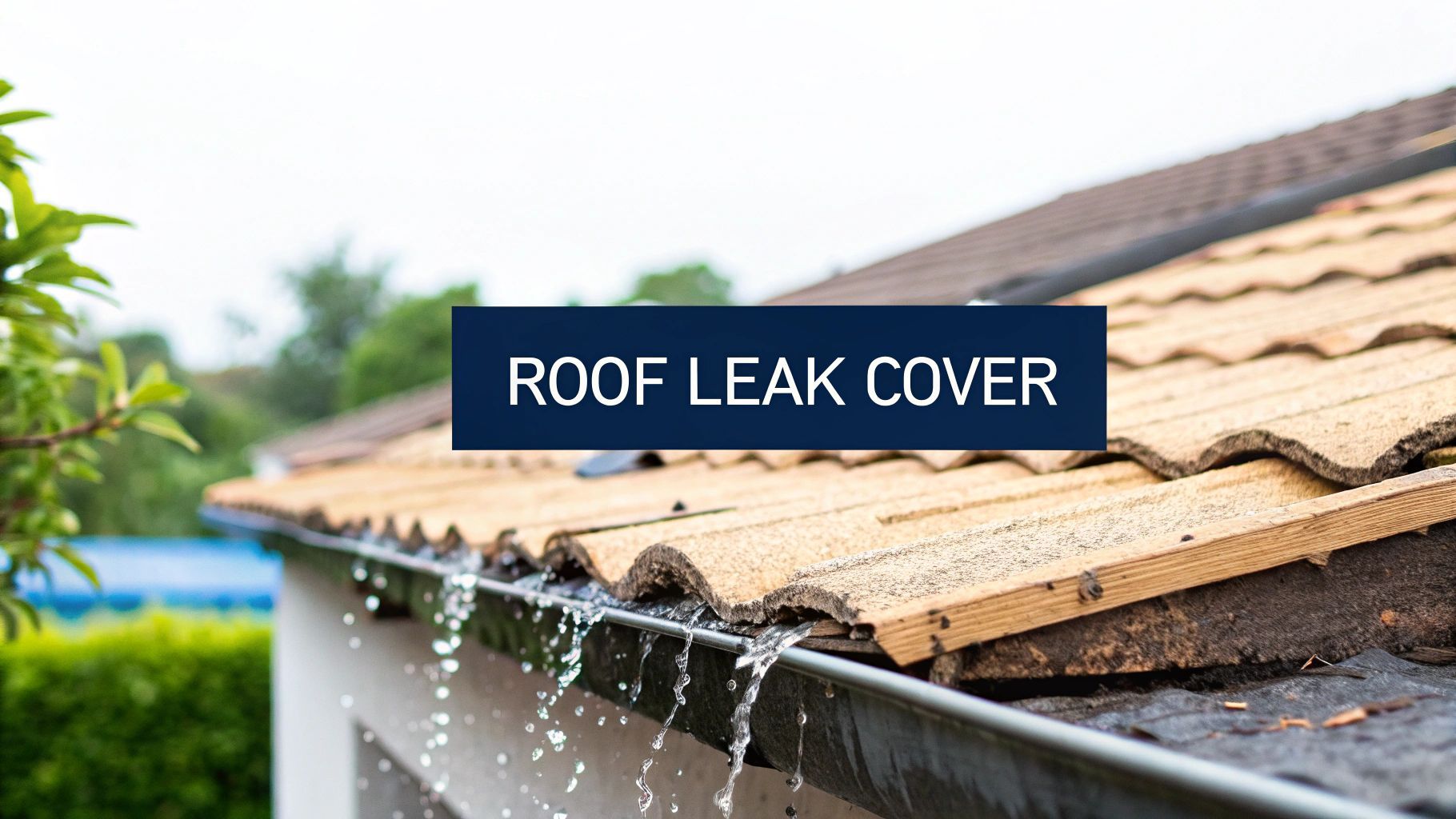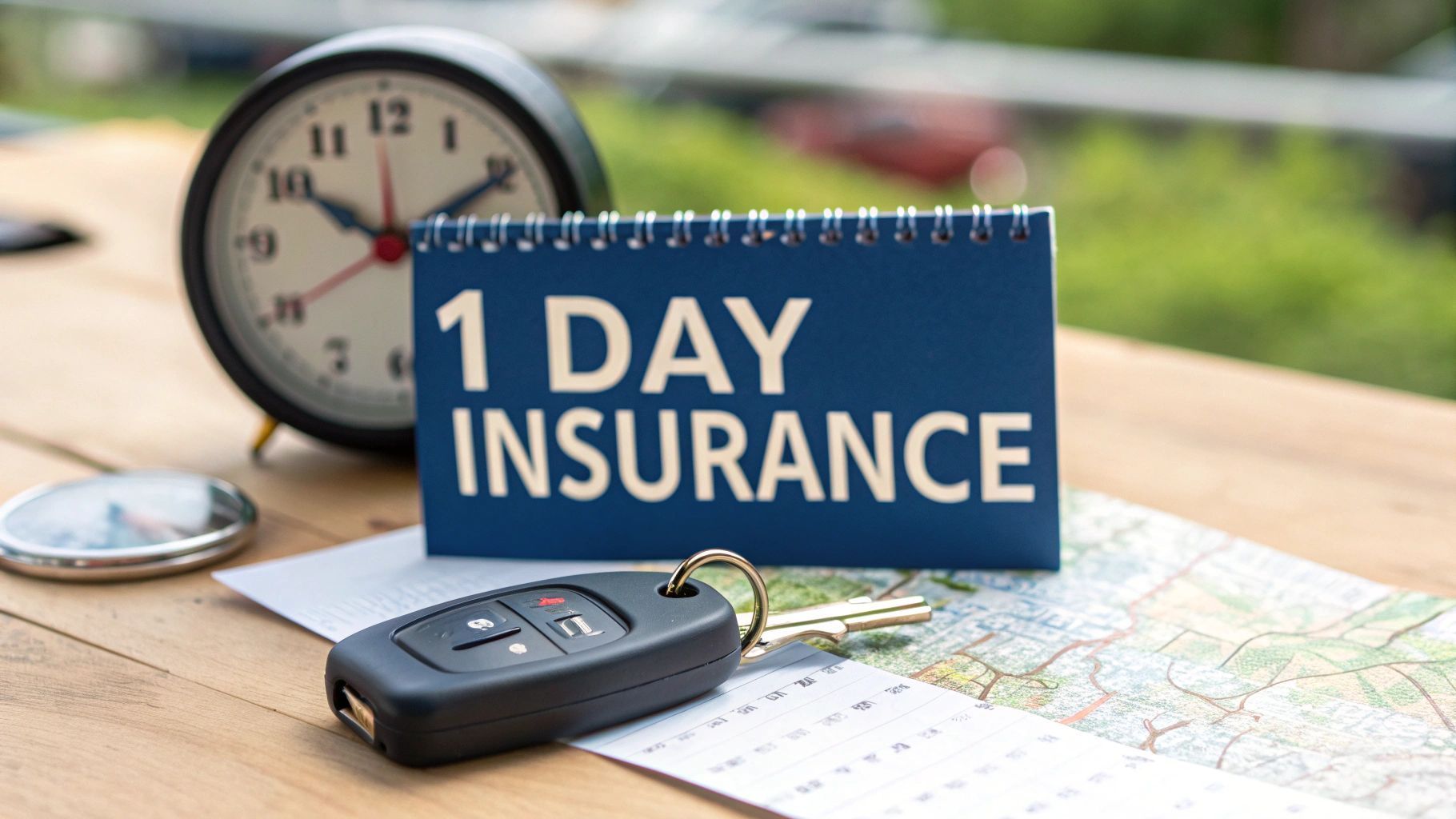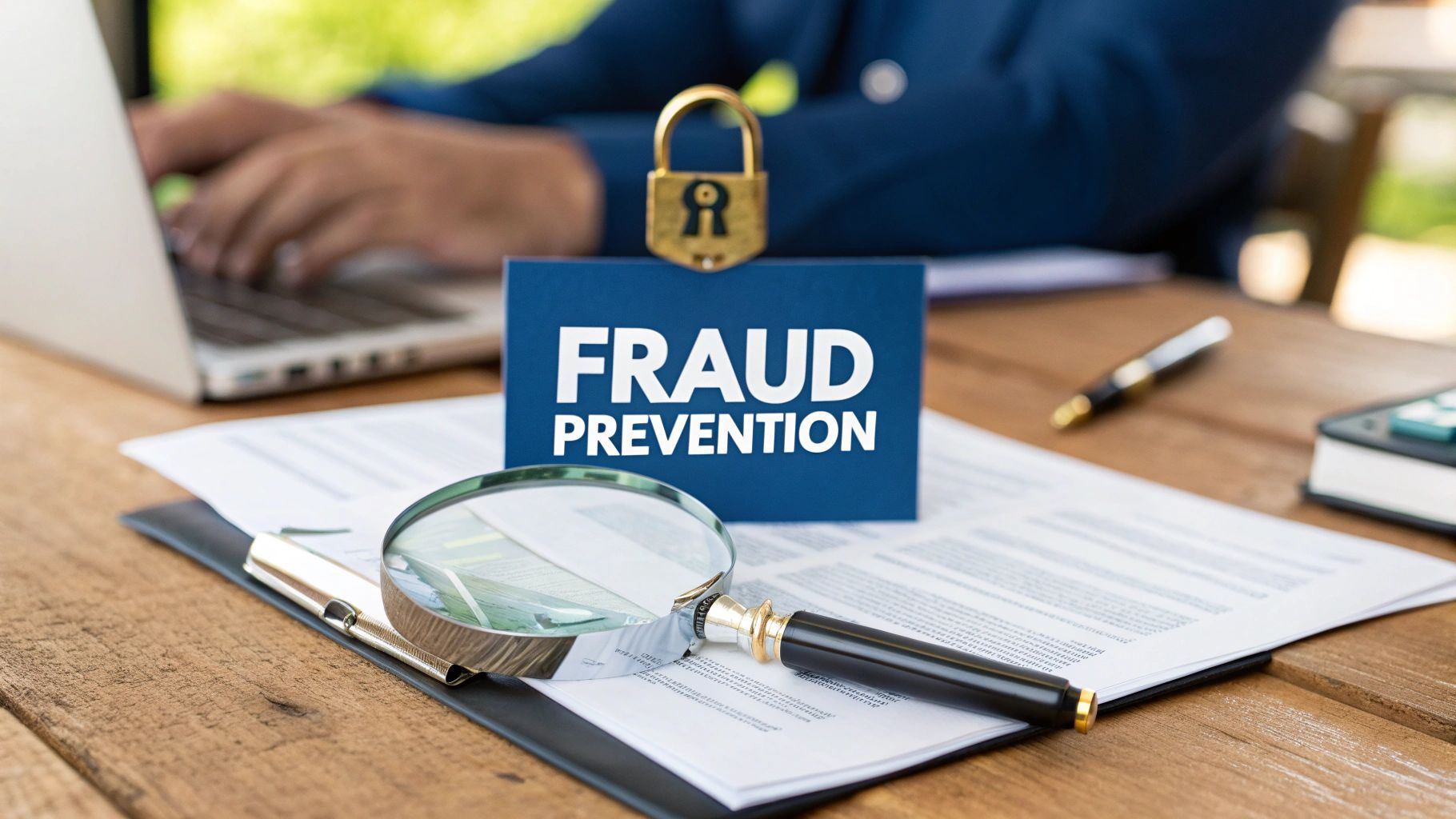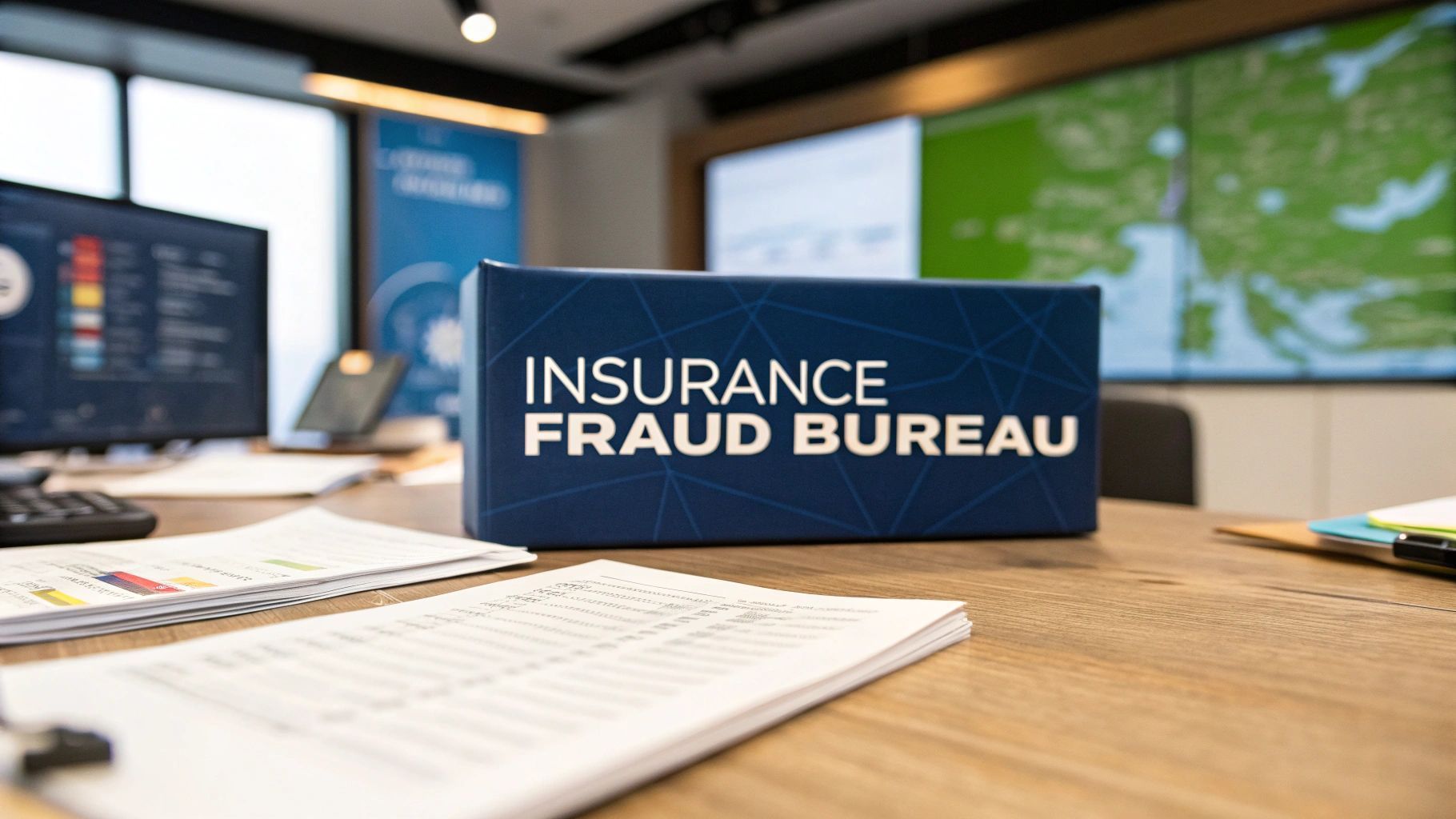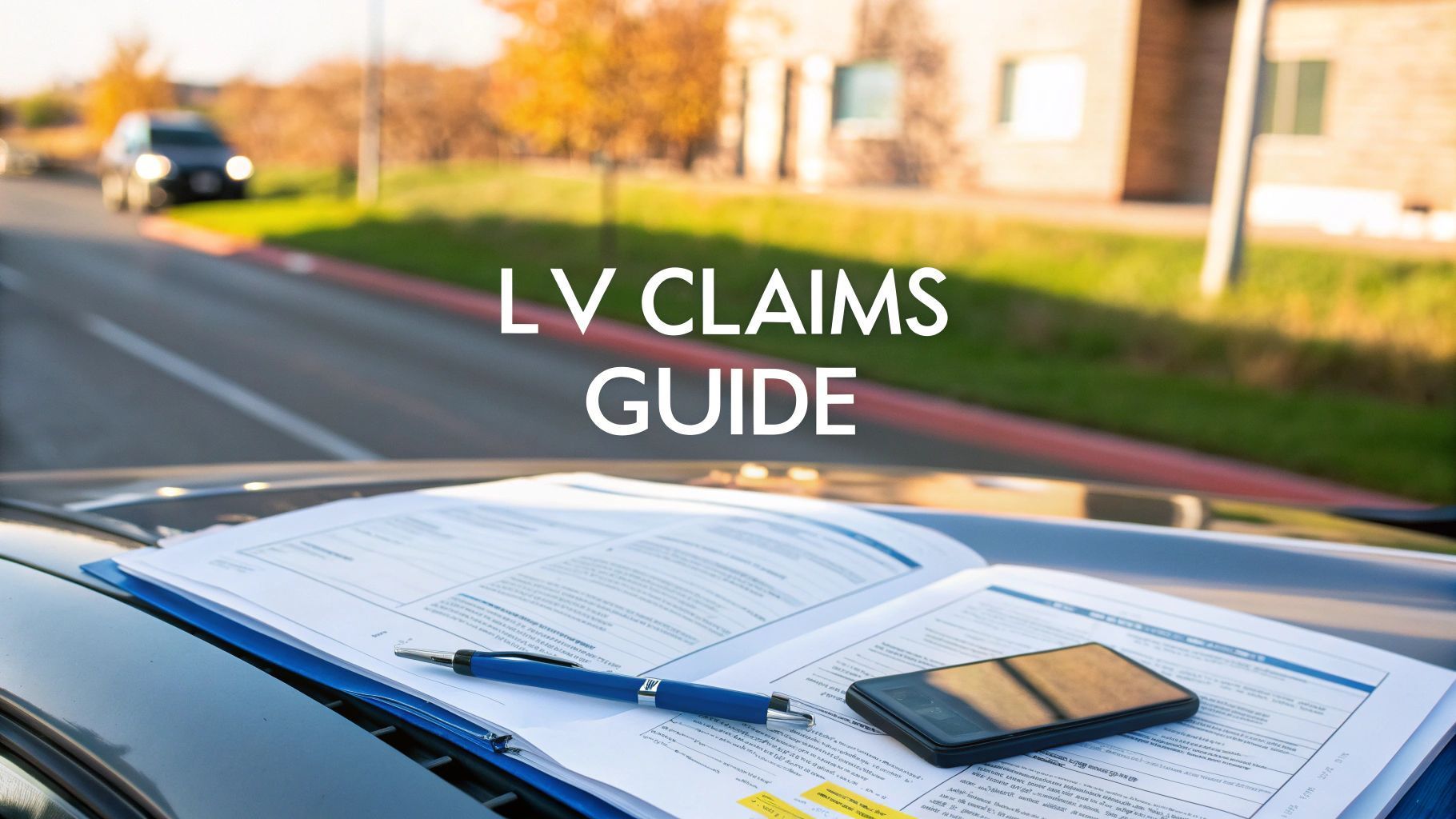Master the Home Insurance Claims Process with Our Guide
Filing a home insurance claim is the formal process of asking your insurer for financial support after your property has been damaged. It all begins with making the site safe, then carefully documenting every bit of the damage, and finally, proving you owned what was lost and what it was worth. It’s a detailed process where the responsibility to provide solid proof falls squarely on your shoulders.
The Reality of UK Home Insurance Claims Today
Let's be candid: making a home insurance claim in the UK is tougher than ever. Insurers are facing enormous financial pressures, which means they're looking at every single submission with a fine-toothed comb. This isn’t personal—it's a business necessity, driven by a perfect storm of economic challenges, rising fraud, and severe weather events.
For one, a changing climate is causing more frequent and severe weather. We're seeing everything from widespread flooding to destructive storms, pushing both the number of claims and the cost of payouts to record highs.
The Soaring Costs of Claims, Fraud, and Premiums
At the same time, stubborn inflation has sent the price of building materials and labour through the roof. A simple repair that might have cost a few hundred pounds a few years ago is now significantly more expensive, adding to the financial strain on insurance companies.
The numbers tell the story. In the first quarter of 2025, British insurers paid out a staggering £886 million for domestic property claims—a 20% jump from the previous year. This has directly led to an 8.5% increase in combined home insurance premiums, with the average policy now costing £231 a year. You can dig into more of these home insurance statistics to see the full picture.
This tough environment has two direct impacts on you:
- Higher Premiums: Insurers have to pass these rising costs on to customers, so everyone’s annual premiums go up.
- Intense Scrutiny: To manage their losses and fight fraud, every claim is put under the microscope.
Insurance fraud isn’t a victimless crime. It is a significant problem that drives up costs for everyone, with estimates suggesting it adds an extra £50 to the average honest UK household's annual insurance bill. This cost is borne by all policyholders.
Why Meticulous Proof Is No Longer Optional
In today's claims landscape, the burden of proof is entirely on your shoulders. It’s not enough to just report that something was damaged. You must provide undeniable, verifiable evidence of what happened, the full extent of the loss, and the value of every single item you're claiming for.
Any ambiguity, a missing receipt, or a vague description can be seen as a red flag. This could lead to delays, a lower payout, or even your claim being denied outright.
In this high-stakes environment, understanding the pressures insurers are under is the first step. The second, and most important, is to prepare your claim with the rigour of a professional case. Your aim is to build a claim so provable that it leaves absolutely no room for questions or doubt. This guide will show you exactly how to do that.
Your First Steps After an Incident Occurs
That initial shock of finding damage in your home is something you never forget. But once that feeling subsides, you need to act, and fast. The first few hours are absolutely pivotal, and what you do right away can genuinely shape the outcome of your entire insurance claim.
Before you even think about the insurance company, your priority has to be safety.
Has a pipe burst? Your first job is to find the stopcock and turn off the water mains. Has a storm shattered a window? You need to get it boarded up as safely and quickly as you can. These aren't just common-sense actions; they're a core part of your policy. Most insurers require you to take reasonable measures to mitigate further loss , and failing to do so can throw a spanner in the works later on.
Document Everything Before You Touch a Single Thing
Right, here's the golden rule: before you move anything or start any cleanup, you need to become a detective. Your phone is your best friend right now. Create an undeniable visual record of the damage exactly as you found it.
This is your primary evidence.
- Go wide first. Take photos from every corner of the room. You need to show the full scale of the situation.
- Then, zoom in. Get close-up shots of the really specific stuff – the crack where the water is coming from, the scorch marks on the wall, the broken lock on the door.
- Switch to video. A slow video walkthrough can be incredibly powerful. As you film, talk about what you're seeing. Point things out. This creates a time-stamped narrative that’s hard to dispute.
Think of this initial documentation as the ‘before’ picture. It’s an honest, immediate snapshot that establishes the true extent of the damage from the very beginning. It forms the bedrock of your claim and leaves no room for your insurer to second-guess the severity of the incident.
Your goal is to create a visual diary so detailed that someone who has never set foot in your home can understand precisely what happened and what was damaged. Don't just take a few snaps; build an unshakeable, provable foundation for your entire claim.
Once you’re confident you have a thorough record—and only then—can you start with temporary, emergency fixes. Make sure you hang on to the receipts for any materials you buy, like tarpaulins or plywood, as these costs can usually be rolled into your claim. It feels like a lot to do in a stressful moment, but this methodical approach is your best defence for a smooth claims process.
Gathering Unshakeable Evidence for Your Claim
Once you've handled the immediate danger, your focus needs to shift to building a solid, provable case for your insurance claim. Let's be frank: insurers work on proof, not trust. A claim without strong, verifiable evidence is an easy one for them to question or dismiss, so your next job is to assemble a file so thorough it leaves absolutely no room for doubt.
This is about much more than the quick photos you snapped in the immediate aftermath. Your mission is to prove two key things for every single item you're claiming: that you actually owned it , and what it was worth . Getting systematic about this is vital, as any gaps or vagueness can raise red flags, slowing down your claim or even reducing your final payout.
Proving Ownership and Value
Sometimes, digging up proof of ownership can feel like an archaeological dig, but it's a non-negotiable part of the process. Your insurer needs to see that the items were genuinely yours before the incident happened. You’ll need to track down any document that connects an item to you.
Start by looking for:
- Financial Records: Bank and credit card statements are fantastic for showing when and where you bought something.
- Digital Footprints: Dive into your email inbox and search for online order confirmations, delivery notes, and digital receipts.
- Original Paperwork: Don't overlook the obvious! User manuals, warranty cards, and even the original boxes often contain serial numbers and other crucial purchase details.
The image below shows the typical journey your claim will take after you've submitted all your evidence.
As you can see, that "Review" stage is where everything gets scrutinised. This is exactly why your evidence needs to be watertight.
To help you get organised, here’s a quick checklist of the essential documentation you’ll want to pull together. A well-prepared file speaks volumes and can significantly speed things up.
Essential Documentation for a Watertight Claim
Use this checklist to gather the critical documents and evidence needed to build a strong and provable home insurance claim.
| Evidence Type | Description & Purpose | Pro Tip |
|---|---|---|
| Photographs & Videos | Captures the extent of the damage from multiple angles. Crucial for showing the immediate aftermath. | Take wide shots of the room and close-ups of specific damaged items. Don't clean up before you've documented everything. |
| Proof of Ownership | Receipts, credit card statements, warranties, manuals, or original packaging. Proves you owned the items you're claiming. | Can't find a receipt? A photo of you using the item (e.g., watching the TV you're claiming for) can sometimes work as secondary proof. |
| Itemised Inventory | A detailed list of every damaged or lost item, including its make, model, age, and estimated replacement cost. | Use a spreadsheet to stay organised. Add columns for the purchase date and original price to make the valuer's job easier. |
| Official Reports | A police report for theft/vandalism or a fire report from the fire brigade. Provides an official, third-party account of the incident. | Get a copy of the report number as soon as possible and include it in your initial communication with the insurer. |
| Communication Log | A record of every call and email with your insurer, noting dates, times, names, and what was discussed. | Keep it simple. A notebook or a running document on your computer is perfect for this. It’s invaluable if disputes arise. |
Having these items ready not only builds a stronger case but also shows your insurer that you are organised, credible, and serious about your claim.
The Problem of Fraud and the Need for Provability
Insurers are, understandably, on high alert for fraud. It's a massive issue that costs the industry billions every year and adds an estimated £50 to every honest policyholder's annual premium. This reality forces them to look at claims with a critical eye. Opportunistic fraud—like exaggerating the value of a lost TV or adding a few extra items that weren't actually damaged—is a huge part of this problem.
When you submit a disorganised or poorly documented claim, it can unintentionally create suspicion. A professional, evidence-backed submission signals that you are serious and prepared, encouraging a much smoother and faster resolution.
This is where provability becomes your most powerful tool. Modern verification technology is a game-changer, allowing you to create an inventory that is independently verifiable. For instance, understanding how geo-location data strengthens insurance claims reveals how tech can add a powerful layer of authenticity, confirming exactly where and when your photos of the damage were taken.
Finally, keep that meticulous communication log we mentioned. Every single phone call, email, and letter you exchange with your insurer should be noted down. This log is more than just notes—it becomes a crucial piece of evidence if you run into disputes or frustrating delays. It transforms your claim from a simple request into a professional, undeniable case for the compensation you deserve.
Submitting Your Claim and Managing the Process
With all your evidence neatly organised, it’s time to formally kick off the claims process with your insurer. This is the moment where all that diligent prep work really starts to pay dividends, turning what could be a chaotic, stressful ordeal into a controlled, professional conversation.
The first official step is usually filling out the claim form, whether you do it online or on paper. Don’t rush this. Treat this document with the attention it deserves because ambiguity is your worst enemy here. Vague descriptions or poorly worded details can unintentionally raise red flags, inviting extra scrutiny from the claims department.
Be specific and stick to the facts you’ve already documented. Your aim is to present a clear, honest, and concise story of what happened and what you’ve lost, all backed up by the solid portfolio of evidence you’ve already built.
Preparing for the Loss Adjuster's Visit
Once your claim is in the system, your insurer will almost certainly appoint a loss adjuster to visit your home. It's crucial to understand who they are and what they do. A loss adjuster is an independent expert hired by the insurance company to investigate the claim, assess the damage, and figure out if your submission is valid and valued correctly.
To be blunt: they don’t work for you. Their job is to verify the facts and make sure the claim fits within the terms of your policy. They are highly trained to spot inconsistencies and will examine everything closely. This isn’t a reason to be nervous; instead, see it as your opportunity to present your case with confidence and professionalism.
Before they turn up, have your ducks in a row.
- Your Evidence Portfolio: Have your photos, videos, itemised inventory, and any proof of ownership ready to go and easy to flick through.
- A Clear Path: Make sure the damaged parts of your home are safe and accessible for them to inspect.
- Your Story Straight: Be ready to walk them through the incident calmly and factually, pointing to your documentation as you go.
Being this prepared sends a powerful signal—it shows you're credible and helps you steer the conversation from the get-go.
Taking Control of the Conversation
When the adjuster arrives, keep a calm and professional demeanour. You have the facts and the proof on your side. Let them do their inspection, but don't just stand back and watch. You should actively guide them through the damage, highlighting specific details and cross-referencing them with your photos and inventory list.
The loss adjuster’s primary role is to verify the insurer's liability. A well-documented, provable claim makes their job far easier and dramatically reduces the chance of disputes, paving the way for a fair and timely settlement.
Think of it less like an interrogation and more like presenting a business case. You're demonstrating a quantifiable loss and providing all the necessary proof to validate it. Answer their questions honestly, but never speculate or guess if you're unsure about something. Just stick to what you know and, more importantly, what you can prove.
The reality is that insurance fraud costs honest UK policyholders a fortune in higher premiums. This means insurers and their adjusters have to be vigilant. By presenting a claim that is meticulously documented and transparent, you’re not just making your own life easier. You’re showing them that your claim is genuine, provable, and deserves a fair settlement without any unnecessary delays.
How Insurance Fraud Hits Every Honest Policyholder
Insurance fraud isn't some victimless crime that only impacts a faceless corporation. It’s a costly problem that lands squarely on the shoulders of every single honest policyholder in the UK. When someone falsifies a claim, it creates a ripple effect, forcing insurers to spread that financial loss across their entire customer base.
The result? Higher premiums for everyone.
Think of it as a hidden tax. Every time you pay your home insurance bill, a slice of that money goes towards covering the costs of fraudulent activities. It’s a massive issue, with estimates suggesting that insurance fraud adds an extra £50 to the average UK household's annual insurance bill. This financial drain is exactly why the entire home insurance claims process has become so rigorous.
Understanding What Counts as Fraud
Insurance fraud isn’t always about fabricating a burglary that never happened. It actually exists on a spectrum, and even what might seem like a minor exaggeration can land a claimant in very hot water. Insurers are constantly on the look out for two main types of fraudulent activity:
- Opportunistic Fraud: This is by far the most common type. It happens when a genuine incident occurs—say, a burst pipe damages your kitchen floor—but the policyholder decides to embellish the claim. Maybe they add a few undamaged items to the inventory list, claim their mid-range TV was a top-of-the-line model, or inflate the quote for repairs.
- Premeditated Fraud: This is far more calculated and involves fabricating an entire event from scratch. This could be staging a break-in or intentionally causing damage to property with the sole intention of making a claim.
Because opportunistic fraud is so widespread, insurers have to approach every claim with a healthy degree of scepticism. It’s not personal; they simply have to verify the details to protect themselves and their honest customers from footing the bill for these deceptions.
The Real Consequences and the Power of Proof
Getting caught has severe consequences that go far beyond just having your claim denied. If an insurer finds evidence of fraud, they won't just reject the inflated parts—they will reject the entire claim, even the legitimate bits. On top of that, they'll cancel your policy and add your details to industry-wide fraud prevention databases.
A record of fraudulent activity can make it incredibly difficult and expensive to get any form of insurance in the future, from car to travel cover. In more serious cases, it can even lead to criminal prosecution and a prison sentence.
This is why the provability of your claim is so critical. A well-documented, transparent submission demonstrates your honesty right from the start and helps insurers quickly separate your genuine claim from a questionable one.
This is where fighting fraud before it happens with a clear, unshakeable record of ownership and condition becomes so powerful. By understanding the industry's perspective on fraud, you can present your honest claim in a way that avoids any unfair suspicion and sails through the process smoothly.
Common Claim Pitfalls and How to Avoid Them
Navigating the home insurance claims process can sometimes feel like a minefield. One wrong step can lead to a reduced payout or, in the worst-case scenario, an outright denial of your claim. It’s a frustrating reality that even the most honest claimants can fall foul of simple, avoidable errors.
Knowing what these common traps are is your best defence against a disappointing outcome.
Being Underinsured: The Hidden Financial Risk
One of the most devastating pitfalls is discovering you’re underinsured, often without even realising it. This happens gradually as you acquire new things over the years, but the financial consequences can be severe. If you’re underinsured, your provider can apply the ‘average clause’ to your claim.
Put simply, this means they’ll only pay out a percentage of your loss, leaving you to cover the rest. It’s a nasty surprise when you’re already dealing with the stress of a loss.
Misinterpreting Your Policy and Its Exclusions
Another classic mistake is failing to fully grasp what your policy does and, more importantly, doesn’t cover. Policy documents can be dense and full of jargon, but you have to push through it. Taking the time to understand the exclusions for specific events like subsidence or certain types of water damage is absolutely critical.
For instance, not all "water damage" is the same in an insurer's eyes. Your policy might cover a sudden burst pipe but specifically exclude gradual damage from a slow, undetected leak that’s been happening for months.
Weather-related damage is another particularly complex area and remains a leading cause of claims in the UK. Insurers paid out a staggering £322 million for damage from storms, rain, and frozen pipes between April and June 2025 alone. This contributed to an overall £1.6 billion in property claims, with the average claim hitting a significant £6,200 . You can learn more about from recent industry reports to see just how common these issues are.
Procedural Mistakes That Can Cost You Dearly
Beyond the fine print of your policy, simple procedural mistakes can completely derail your claim. These are some of the most frequent and costly errors we see people make:
- Throwing away damaged items too soon. Never, ever get rid of damaged possessions before your insurer or their loss adjuster has had a chance to inspect them. Those items are the core evidence of your loss; without them, you have no proof.
- Starting non-emergency repairs without approval. It's your responsibility to prevent further damage—like putting a tarp over a hole in the roof. However, starting full-scale repairs before your insurer gives the green light can void your claim. They need to assess the original damage first.
- Accepting the first settlement offer without question. The initial offer from an insurer is often just that—an opening offer. If it feels too low and doesn't match up with your documented evidence and repair quotes, you have every right to negotiate. Don't be afraid to push back.
Accepting an inadequate settlement can leave you with a massive financial shortfall, unable to properly repair your home or replace your possessions. Always compare the offer against your own detailed inventory and repair estimates before you even think about agreeing.
Ultimately, these pitfalls highlight why a methodical, evidence-based approach is so important. When you present a claim that is meticulously documented and professionally managed, you remove the grey areas that can lead to disputes and delays. If you want to understand more about your options, you can explore why your insurance company might refuse to pay a claim in more detail.
Managing your assets and preparing for a potential claim doesn't have to be a struggle. Proova provides a simple, effective way to create an indisputable record of your possessions, making the home insurance claims process faster and fairer. Secure your peace of mind by visiting https://www.proova.com to learn more.


